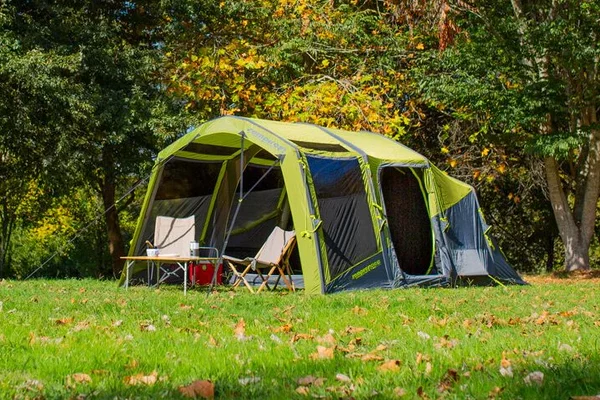Tents have been a crucial part of outdoor life for centuries, serving as portable shelters that allow humans to explore and enjoy nature while staying protected from the elements. Whether you’re an avid camper, an occasional festival-goer, or someone who simply enjoys the occasional weekend in the wilderness, understanding the various uses and benefits of tents can enhance your outdoor experience.
SEE ALSO: The 10 Best Portable Camping Shower
Primary Function
Shelter from the Elements:
The primary purpose of a tent is to provide shelter from the elements. When you’re outdoors, you’re exposed to unpredictable weather conditions. A tent acts as a barrier against rain, wind, and sun, keeping you dry during a downpour, shielding you from strong winds, and providing shade on a hot day. The material of the tent, typically water-resistant or waterproof, ensures that you remain comfortable inside, no matter what the weather throws your way.
Sleeping Space:
Beyond mere protection, a tent serves as a designated sleeping space. It offers a comfortable area where you can rest and rejuvenate after a day of outdoor activities. Tents are designed to keep out insects and other critters, ensuring you have a peaceful night’s sleep. Whether you’re camping alone or with a group, a tent provides a personal space to unwind, read a book, or simply relax in nature.
Types of Tents and Their Uses
There is a wide variety of tents available, each designed for specific needs and scenarios. Understanding the differences can help you choose the right tent for your adventure.
Dome Tents: These are among the most popular types of tents, characterized by their rounded shape and flexible poles. Dome tents are easy to set up, lightweight, and offer good stability in windy conditions. They are ideal for short camping trips and are suitable for a variety of weather conditions.
Tunnel Tents: Tunnel tents are designed with parallel poles, creating a long, tunnel-like structure. These tents are known for their spacious interiors and are great for families or groups. They offer excellent headroom and storage space but require more effort to set up compared to dome tents.
Backpacking Tents: As the name suggests, backpacking tents are designed for hikers and backpackers who need lightweight and compact gear. These tents prioritize portability and ease of setup, making them perfect for long treks where every ounce of weight matters.
Family Tents: Family tents are large and spacious, designed to accommodate multiple people comfortably. They often come with separate sleeping areas, living spaces, and additional features like windows and doors. These tents are ideal for extended camping trips with family or friends.
Pop-up Tents: For those who prioritize convenience, pop-up tents are a great choice. These tents literally “pop up” when taken out of their bag, requiring minimal effort to set up. They are perfect for festivals or short camping trips where ease of use is a priority.
Benefits of Using a Tent
Privacy and Personal Space:
One of the key benefits of using a tent is the sense of privacy it offers. In a public campground or at a busy festival, a tent serves as your personal retreat, a place where you can change clothes, relax, and sleep without feeling exposed. It creates a boundary between you and the outside world, giving you a sense of security and personal space.
Connection with Nature:
While a tent provides protection and privacy, it also allows you to stay connected with nature. The thin walls of a tent keep you close to the sounds of the outdoors, whether it’s the rustling of leaves, the chirping of birds, or the sound of rain. Tents offer a unique way to experience the natural world, allowing you to immerse yourself in the environment while staying safe and comfortable.
Essential Considerations
Size and Capacity:
When choosing a tent, one of the first things to consider is its size and capacity. Tents are typically rated by the number of people they can accommodate. However, it’s important to note that the stated capacity might be a tight fit if you have a lot of gear or if the occupants prefer more space. For example, a “four-person tent” might be more comfortable for two or three people if they have backpacks or other equipment with them.
Weather Conditions:
Different tents are designed for different weather conditions. If you plan to camp in a region with heavy rainfall or strong winds, you’ll need a tent with sturdy poles, a robust rainfly, and a high waterproof rating. For camping in hot climates, ventilation is key, so look for tents with multiple mesh panels and windows. Understanding the weather conditions of your camping location will help you choose a tent that offers the right level of protection.
Examples of Tent Use
Imagine setting up your dome tent on a secluded mountain trail, the lightweight design making it easy to carry and pitch after a long hike. Or picture a family enjoying a weekend at a campground, their spacious tunnel tent providing ample room for everyone to sleep, store gear, and even gather for meals. At a music festival, a pop-up tent offers the perfect blend of convenience and comfort, giving festival-goers a quick and easy place to rest between performances. Each scenario highlights how a tent can enhance the outdoor experience, offering protection, comfort, and a connection to nature.
In conclusion, tents are an essential piece of outdoor equipment, offering shelter, comfort, and a sense of privacy. Whether you’re an experienced camper or a beginner, understanding the various types and uses of tents can help you make the most of your time outdoors.

